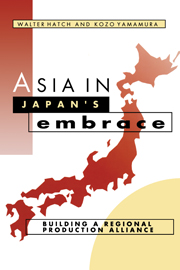Book contents
- Frontmatter
- Contents
- List of Tables
- List of Figures
- Preface
- Part One Co-Prosperity Again
- 1 Crossing Borders: The Japanese Difference
- 2 Flying Geese: An Unequal Alliance in Asia
- Part Two The Embracer and the Embraced
- Part Three A Japanese Alliance in Asia
- Part Four A Powerful Embrace
- Notes
- Select Bibliography
- Index
2 - Flying Geese: An Unequal Alliance in Asia
Published online by Cambridge University Press: 05 February 2012
- Frontmatter
- Contents
- List of Tables
- List of Figures
- Preface
- Part One Co-Prosperity Again
- 1 Crossing Borders: The Japanese Difference
- 2 Flying Geese: An Unequal Alliance in Asia
- Part Two The Embracer and the Embraced
- Part Three A Japanese Alliance in Asia
- Part Four A Powerful Embrace
- Notes
- Select Bibliography
- Index
Summary
In the late 1950s, Japanese investment in East and Southeast Asia was designed almost exclusively to extract raw materials for the home market. Firms in labor-and capital-intensive industries – textiles, chemicals, and steel – shifted some of their production to the region in the 1960s and 1970s, when wage rates, land prices, and environmental regulations in Japan began to pinch their domestic operations. These manufacturers had another motive, namely, to continue to supply markets that host governments in Asia had begun to protect.
That was the “old wave” of Japanese FDI. Conventional wisdom suggests that, beginning in the mid 1980s, three factors conspired to create a “new wave” of export-oriented investment in Asia. The first was the deliberate effort by a number of Southeast Asian states to jump-start their sluggish economies by adopting policies to attract foreign investment and stimulate exports. Firms from Japan, as well as the United States, Europe, and the Asian NICs, responded enthusiastically. The second factor was the equally deliberate effort by some of Japan's most important trading partners, principally the United States, to erect new barriers to Japanese exports. To circumvent those barriers, Japanese firms not only invested heavily in the United States and Europe, but also scurried to construct export platforms in Asia. The third and most frequently cited factor was the Plaza Accord, which triggered a chain reaction that ultimately led to an eruption of Japanese capital.
- Type
- Chapter
- Information
- Asia in Japan's EmbraceBuilding a Regional Production Alliance, pp. 20 - 40Publisher: Cambridge University PressPrint publication year: 1996



